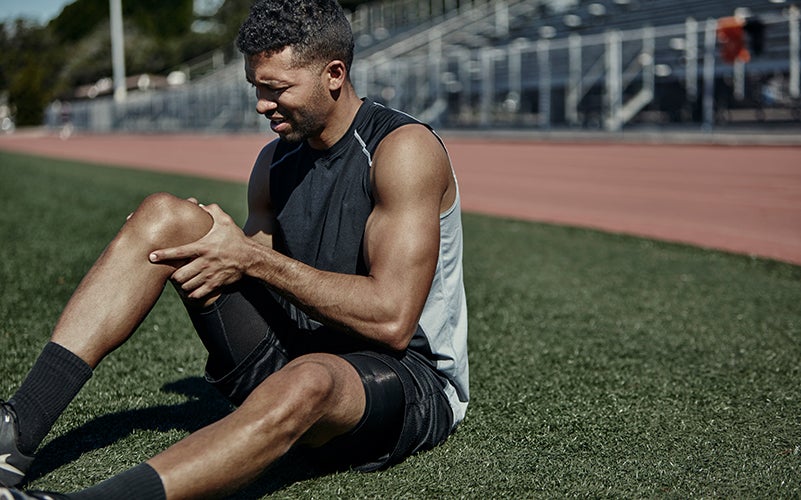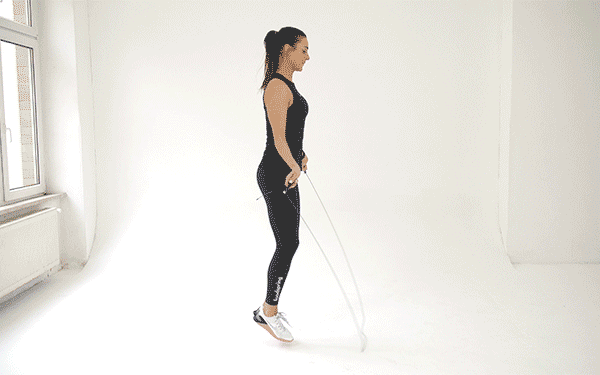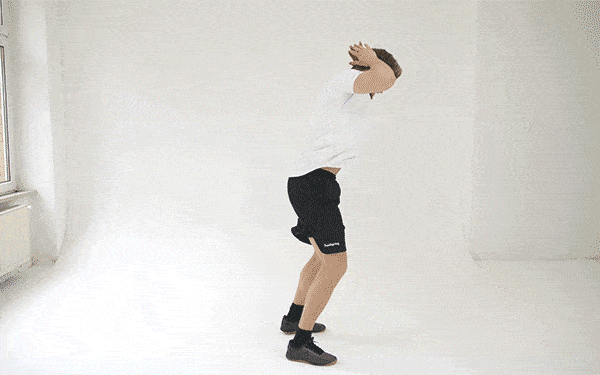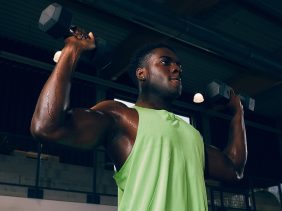How to avoid, prevent, or relieve muscle soreness
 ©Patrik Giardino
©Patrik Giardino
Are you always extremely sore after you leave the gym? We’ll tell you how to alleviate your pain, in the moment and the long run! First we’ll dive into what muscle soreness is and how you can avoid it. Then, we’ll share our best tips to avoid muscle soreness before your next workout.
What are the aches and pains you feel after exercise?
Even if you’re not much of a fitness junkie, we all know what it’s like to be sore. Even if it’s been awhile since you’ve experienced it, you surely will the next time you work out. To give a quick summary, what happens directly after exercising is that your muscles feel weak, and then eventually tighten or swell as time goes on. When you wake up the next morning, the muscle tension may be so bad that it prevents you from moving properly — this is also known as delayed onset muscle soreness. In the worst case scenario, these painful sensations can last all week. The good news is that the aches and pains don’t damage your muscles permanently. And the more you do the same workout, the less you’ll experience delayed onset muscle soreness as you progress.
What effect does muscle soreness have on the body?
A workout isn’t necessarily the only thing that will make your muscles sore. Every major physical exertion or unusual movement can cause aches and pains. For your body, these movements are synonymous with stress and strain. And the more you repeat a movement, the more you’ll start to develop small tears in your muscle tissue.
When there’s a tear in your muscle fibers that means that the cells in that spot have died. It’s not serious, but it is painful. In a process called autolysis, the dead muscle fiber breaks down independently and uses the enzymes in your body to rebuild itself again—only stronger this time. And you’ll know it’s happening when you’re in pain. When the muscles have fully healed, you will be able to move normally and painlessly again.
Muscle pain is not muscle acidosis.
Sore muscles are sometimes associated with acidosis, which is when you have an abnormally acidic pH in the blood of the affected areas. It’s usually a result of eating a diet that’s overly rich in acid-forming foods. But the burning sensation you experience in your muscles after a workout is caused by something different — it’s often an excess of lactate in your body, which is overproduced when your muscles aren’t getting enough oxygen.
When you’re physically active, your body needs more energy than if you were to sit on the couch all the time. Your body uses carbohydrates to fuel itself by turning them into glucose with the oxygen you absorb while breathing. However, if you’re working out for a long time, the oxygen levels in your body won’t be high enough to sustain your energy levels the whole way through. This is when the body switches to an anaerobic metabolism, which allows you to get energy from carbohydrates without oxygen, but also causes you to produce a larger amount of lactate, also known as lactic acid. If the body produces more lactic acid than it’s able to remove, it will become too acidic, which can cause a burning muscle pain. After the feeling has stopped, that usually means the lactate has broken down.
How long do the aches and pains last?
The length of time it takes to recover from muscle soreness varies from person to person. Severe aches and pains can last up to a week, but, in most cases, they only last a few days. Afterwards, you can move and exercise as usual. If you still have severe muscle pain after a week, we recommend consulting your doctor to see what might be causing it. Post-workout sore muscles should not cause permanent damage and may be a sign of something serious if they stick around for too long.
In general, someone who is physically fit will recover faster than someone who is not and will experience less delayed onset muscle soreness. But how you eat also plays a big role. For example, a protein-rich diet will minimize muscle pain because you will have all the essential nutrients they need to recover. A person in good physical condition recovers faster than a person who does not exercise. And eating in a healthy and balanced way will have an overall positive influence on your general health.
Our tip: our Whey Protein is exactly what you need to prevent muscle soreness. Added to a smoothie, it can easily be consumed directly after workouts or as a snack to make sure you supply your body with enough protein.
Can we prevent soreness?
Though a workout may feel more successful if you’re sore afterwards, it’s better when it doesn’t. That’s because tears in your muscle tissue, however small, are still technically injuries. And, as with all injuries, you should wait until your body has fully recovered to restart your training.
To prevent soreness, try to make a big effort for only a short period of time. For example, if you feel pain in your legs when you ride your bike, ride a little slower. Even during training, you should lower the intensity level as soon as you feel muscle pain. Raise the level slowly and you’ll find that your muscles will be able to withstand the tension for longer and longer. Just ignoring the pain won’t help. In the end, your muscles will only get more seriously injured and you will have to stop exercising for longer.
Your diet also has a significant influence on whether or not you experience muscle soreness and how quickly you recover. The healthier and more balanced your diet is, the better your metabolic process will function. Your muscles are made up of various amino acids and need a certain supply of micronutrients to help you recover as efficiently as possible. The better you eat, the faster you’ll be able to build muscle, and the less you’ll experience muscle soreness.
Why do I keep getting sore?
If you’ve followed all of our tips and are still experiencing soreness, something else may be causing it. For one, your endurance levels may not be high enough. That just means that your muscles are not able to sustain an effort for too long. You can develop your endurance levels by exercising more frequently but less intensively. Aim to do more repetitions with less weight. Once you can do 15 to 25 without pain, move on to another workout.
And there are plenty of workouts you can do at home with just your own body weight — no tools required. That way you’re able to maintain your strength between classes or gym trips, or if you can’t go out for whatever reason. Check out our very own free foodspring workouts to get yourself started. There’s something there for everyone!
These exercises are perfect for increasing your endurance and avoiding soreness:
Jumping Rope

| Difficulty: | Easy |
| Target: | Endurance |
| Important: | Hold the handles in line with your belly button. You can also do this exercise without a jump rope, as well. |
High Knees

| Difficulty: | Medium |
| Target: | Endurance |
| Important: | Always keep your upper body upright. |
Burpees

| Difficulty: | Hard |
| Target: | Strength and endurance |
| Beachte: | Keep your back straight, and your abs and your core activated through the entire exercise. |
The point of HIIT (High Intensity Interval Training) is to perform high intensity exercises in a short period of time and it’s a good way to build up your endurance so that you’re less sore after a workout. And you can modify HIIT to suit your needs, whether that’s lifting heavier weights or running longer distances.
Our tip: If you’re sore often, give our Recovery Aminos a try. Mix it with water and sip all the amino acids and carbohydrates your muscles need in one go.Try recovery aminos now
What to do when you are sore.
While there’s no miracle cure for post-workout sore muscles, we have a few tips that will help reduce muscle soreness.
1. Take a hot shower.
Give yourself a nice hot shower after practice. Warm water stimulates blood flow in the muscles — which reduces muscle soreness — and the cell regeneration process.
2. Go to the sauna.
If you can, go to the sauna! Not only will the heat be good for your muscle soreness and blood flow, but you will also enjoy a real moment of relaxation.
3. Do a low-intensity workout.
Doing a low-intensity workout when you’re sore can do a lot to make you feel better. Moving your muscles better allows oxygen to circulate, which can help speed up the recovery process. However, you don’t necessarily need to head to the gym to do this. Often riding a bike or going for a walk is more than enough.
4. Eat a balanced diet.
Eating well will also make you feel well. If you get all the macro- and micronutrients you need, every little cell in your body will be grateful. And it will ensure your sore muscles recover quickly.
For example, you could prepare yourself a warm bowl with a good source of protein — it’s tasty and very simple to make. How about a sweet potato and chicken bowl?
5. Consume zinc and magnesium to boost your energy.
If you exercise a lot, your body needs more micronutrients. Zinc and magnesium have a lot of what your sore muscles need post workout, and our ZN:MG capsules are a great way to get both at the same time. Not only will they help you recover faster, they’ll also help you concentrate more and feel less tired. Try zn:mg now
Once again, it’s important to keep in mind that there are no miracle products for soreness. And it’s also important not to overwork your body while recovering. If you put too much stress on the muscle tissue, your recovery process will have to start all over.
Unfortunately time is the only true cure to muscle soreness. Wait until you’re feeling better again before you restart your training.
Working out despite soreness.
It doesn’t matter if your soreness is severe or only mild — having any soreness at all means your muscles are injured, and it’s never recommended to train under these circumstances. Be patient! Even if you think a long break is too long, it’s the only thing that will help your sore muscles properly recover.
Here’s what might happen if you work out while sore.
If you’re still sore that means your body is still in the recovery phase, when dead parts of muscle cells are eliminated and new cells are developed. Working out will cut this process short by re-tearing muscle tissue before it’s had a chance to fully regenerate. What’s worse is that your muscles can’t even build new cells while it’s recovering, so a workout will lengthen your recovery time without even strengthening your muscles.
Our conclusion
- Muscle soreness is caused by long and novel physical exertion. It can be caused by daily movements, but also by exercise.
- You can treat soreness with low-intensity workouts. A hot shower or a trip to the sauna can also help. However, keep in mind that there is no miracle method. The best thing to do is to take a break: don’t exercise for a while!
- As a general rule, soreness lasts a few days and up to a week. If you are still experiencing severe pain after seven days, we recommend that you consult a doctor. You may have pulled a muscle.
- It is not recommended to train with sore muscles. Give your body time to recover. After that, you can resume training where you left off.
Sources for this article
We at foodspring use only high-quality sources, including peer-reviewed studies, to support the facts within our articles. Read our editorial policy to learn more about how we fact-check and keep our content accurate, reliable, and trustworthy.

































